The God is a Geek Retro Corner: Happy 25th Birthday – Top 10 NES Games
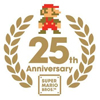 He has saved the world, on at least 10 occasions. He has his own football team, Motor Racing competiton and his own tennis tournament. He paints, teaches typing and even dabbles in World History. He may be a medical professional, but he still loves to party.
He has saved the world, on at least 10 occasions. He has his own football team, Motor Racing competiton and his own tennis tournament. He paints, teaches typing and even dabbles in World History. He may be a medical professional, but he still loves to party.
Considering he is turning 25 this October, Mario has accomplished a lot in his lifetime.
Super Mario Brothers was first released in 1985. Some estimations now put the number of instalments of Mario and Mario-related spin off games at over 250 titles. That is a lot of ground for one little plumber to cover. Mario did feature in several games before SMB, such as Donkey Kong and the original arcade game Mario Bros, but Nintendo seems to have decided 2010 is the 25th birthday of our moustache-wearing friend.
The 18th October also marked the 25th birthday of another icon of video gaming. The NES – Nintendo Entertainment System – was also launched in the United States and Europe in 1985 (Japan already had it back in 1983). To mark the two events, Nintendo has issued new marketing materials, a special edition Wii and the forthcoming Super Mario All-Stars 25th Anniversary Edition, to name just a few of their efforts.
In our attempt to celebrate the anniversary of such an influential console, which revolutionised home video gaming and set the standard for consoles to be measured by for years to come, we present to you our top ten NES games of all-time. This is a subjective list, which takes into account personal opinion as well as influence the games had and marketplace success. This list is far from definitive, but constitutes titles which GodisaGeek.com believes are classics, and you should go out and play, if you haven’t already.
 10. Battletoads (1991)
10. Battletoads (1991)
This has proven to be somewhat of a marmite game. Developed by Rare, the game was an obvious attempt to cash in on the then-popularity of Teenage Mutant Ninja Turtles craze, by featuring humanoid-anmials, and on the Double Dragon series, in terms of gameplay. However, what may have looked like a lazy idea actually turned out good. Very good in fact. The game felt like an arcade beat-em-up and contained a lot of variety in level design. Some levels had you racing jetbikes, whilst another featured rapelling down cliff-faces – interspersed between more traditional fighting and platforming elements.
The graphics were also impressive. Released towards the end of the active cycle of NES games, it is perhaps oneof the best looking games on the system – with bold cartoon sprites, which more than rivalled the ones offered in any Turtles console outing. It also featured 2 player co-op play – to further replicate the authentic arcade experience.
 However, what everyone remembers about this game is how damn hard it is. The racing levels were insane – they were more or less trial and error exercises in memory and split-second timing. Platforming elements required precision aim, and bosses were very unforgiving. Only one game I have played would I say is more difficult – and that is coming further down our list! Playing in co-op didn’t make things easier either. Players would get in one another’s way, pushing each other off platforms. Friendly fire was a constant issue, with each player able to harm one another. And the three continues you were given in single player? They were now split between the two of you. The game didn’t give an inch and very few players ever saw further than level 3 – of the whopping 11 levels included.
However, what everyone remembers about this game is how damn hard it is. The racing levels were insane – they were more or less trial and error exercises in memory and split-second timing. Platforming elements required precision aim, and bosses were very unforgiving. Only one game I have played would I say is more difficult – and that is coming further down our list! Playing in co-op didn’t make things easier either. Players would get in one another’s way, pushing each other off platforms. Friendly fire was a constant issue, with each player able to harm one another. And the three continues you were given in single player? They were now split between the two of you. The game didn’t give an inch and very few players ever saw further than level 3 – of the whopping 11 levels included.
A very challenging game then, but a solid arcade fighter.
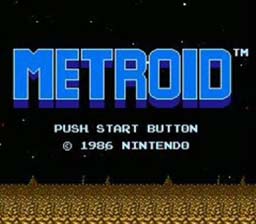 9. Metroid (1986)
9. Metroid (1986)
One of Nintendo’s perennial franchises, Metroid was truly ground-breaking on the NES. This was one of the first titles that really pushed the boundaries of open-world play and exploration. The title encouraged exploring and offered a non-linear maze-style construction of interconnecting screens – which could be traversed at the players will. This translated into one big map, which could be travelled trough at your own pace. This of course sounds bog-standard by current standards – but at the time, this was unlike anything else we had seen before. Offering this kind of freedom to the player was liberating and really made it feel like you had a say over what direction the game headed in.
Add to the mix RPG-lite weapons and armour upgrades, and the game was quite ahead of its time in respect to innovative features.
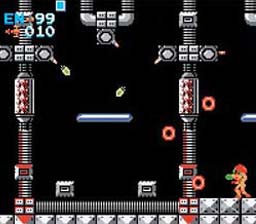 The graphics and presentation were equally impressive, creating a varied world with exotic enemies and the memorable arch-nemesis; Mother Brain.
The graphics and presentation were equally impressive, creating a varied world with exotic enemies and the memorable arch-nemesis; Mother Brain.
But perhaps the other main talking point of this game comes upon the realisation that the spacesuit-clad hero we have been controlling for the whole game is actually a woman. At the time of its release, there were no female gaming heroes. The girls in early videogames were always damsels in distress – there to be rescued, not the one doing the fighting. The game was revolutionary also in this regard, and Samus Aran has become one of the most enduring characters from Nintendo, even returning to the style of the early installments in the series recently in the semi 2D/3D action-adventure: Metroid: Other M.
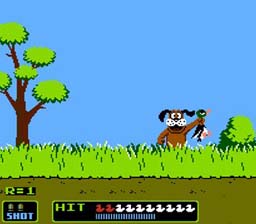 8. Duck Hunt (1984)
8. Duck Hunt (1984)
Being bundled in with many of the NES console packages made this game one that many people will have played, without necessarily buying it. There aren’t a lot of NES owners who wouldn’t have played this game at one point or another, but it is a good title in it’s own right. The first game to utilise the Zapper accessory, the game consists of three very simple modes, and there is little variety in the gameplay. But it is the simple game mechanics that make this title so addictive. You can easily drop in and out of this title, just for a few quick rounds. The action will be fun and immediate – the light-gun being surprisingly responsive for such an early title. It is easy to cheat on the game though – just press the barrel up to the screen and you can’t miss! The advent of flat-screen TV has confined this game to the cupboard though, as the Zapper just won’t work without the scan lines of tube Televisions!
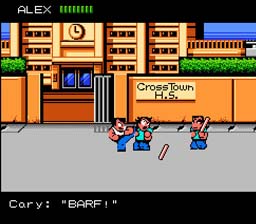 7. River City Ransom (1989)
7. River City Ransom (1989)
One of the hidden gems among the throng of movie licenses and sports titles, River City Ransom combined Double Dragon-style fighting with lite RPG elements to great effect. Two-player co-op fighting was also available, as was the trend with scrolling beat-em-ups. The city of the title is populated with street gangs waiting for a fight, whilst the player can also make use of neutral zones, where shops and restaurants supplied food powerups and character upgrades. Levelling up and learning new techniques in this way is vital for battling later street punks, and this leads to a greater strategy element to the title – working out what you need to save for in order to pass a certain area. Perhaps what makes the title so endearing though is the strange captions some of your enemies spew forth in the heat of battle!
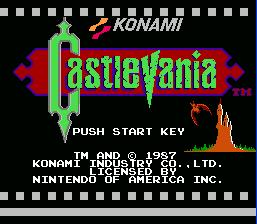 6. Castlevania (1987)
6. Castlevania (1987)
In another showing of the enduring power of some of the top NES titles, one of its foremost franchises was the Castlevania one – which has recently been updated for the HD crowd, to much acclaim. There have been many updates, sequels and prequels in the series so far, but most of them share many of their key elements with this first, iconic title. The graphics on display were ahead of most other releases at the time, and sounds effects and music rose above the standard bloops and bleeps to really recreate the feeling of dread of exploring the castle of Dracula. The animation was also smooth and detailed for the time, making the game stand out from the mass of other action/platform hybrids that swamped the system.
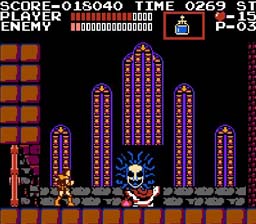 The detail that forms the foundation of this and most other Castlevania games since is the gameplay. The whip-toting hero has developed to have more and more skills, but the whip remains as his iconic weapon of choice. The player could use the whip to find powerups and unveil hidden items, as well as being the primary attack. Secondary weapons such as throwing daggers were also available, but it is the whip that became the series icon.
The detail that forms the foundation of this and most other Castlevania games since is the gameplay. The whip-toting hero has developed to have more and more skills, but the whip remains as his iconic weapon of choice. The player could use the whip to find powerups and unveil hidden items, as well as being the primary attack. Secondary weapons such as throwing daggers were also available, but it is the whip that became the series icon.
As you might find is becoming the trend with a lot of NES games, this is one tough title to get through. Only 6 levels stand between the player and defeating Dracula, however those are some challenging stages, and control quirks only add to the feeling of frustration you feel just when you think you might finally get past the level that always stumped you. But the atmosphere and setting were streets ahead of its competition.
 5. Mega Man 2 (1989)
5. Mega Man 2 (1989)
Coming out right on the heels of the first game in the saga, Mega Man 2 improved on its predecessor in almost every way. The thing which really stands out is the very clever enemy desighn. The staple of the series became bosses who each had their own theme and powers – Drill Man, for example, is fairly self-explanatory. The player could pick which enemy to go after as they pleased, giving an extra level of choice to proceedings. Yet another platforming-action hybrid, the game stood out due to its cartoon art style, which still stands up well today – as shown by current-gen DLC update Mega Man 9 – which still uses the same graphic style today. The music too, was catchy, but not irritating – this is where Capcom began to establish themselves as a major player in the console game market.
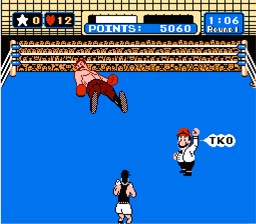 4. Mike Tyson’s Punch-Out!!! (1987)
4. Mike Tyson’s Punch-Out!!! (1987)
Later re-named, due to the troubles suffered by Mike Tyson in his career and life, the two versions remain identical – aside from the final boss – who was of course, Iron Mike in the original version. Adapted from their arcade game of the same name, Nintendo managed to create an over-the-top cast of villains to battle your way through, using super-powered star punches and well-timed dodges. It wasn’t so much a free boxing title as one about patterns and learning sequences of attack. Dodge right, dodge left, punch. You had to pick and choose your opportunities so as not to be flattened by your opponent. The over-the-shoulder viewpoint was innovative and ahead of its time, and the simplistic fun of the title has led to SNES and Wii remakes, which still don’t stray far from the original formula.
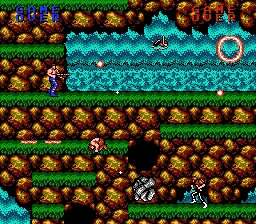 3. Contra (1988)
3. Contra (1988)
Personally, this game would probably top my list if it wasn’t SO DAMN HARD! This is possibly the hardest videogame ever made. There is a reason that everybody remembers the cheat code that gave 30 extra lives this game – it’s because everyone had to use it to get anywhere through the title. Play as one of two topless rambo-alikes in one of the most basic plots you can imagine. The game alternates between side-scrolling and pseudo 3D sections, but what really stands out is the non-stop onslaught of action. And it is FUN. Add in the option of 2-player co-op, this is the ultimate multiplayer experience on the NES. Admittedly, later iterations of the game improved on the graphics, and somehow got arguably harder – this remains the most straightforward and playable title I can remember. But a game should be beatable without having to cheat!
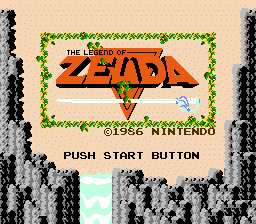 2. The Legend of Zelda (1987)
2. The Legend of Zelda (1987)
The game that started it all. Take a look at this game in action and you can see how little the overall concept changed when the game moved to the Super Nintendo and then the Gameboy – the foundation laid was so solid. The series has since gone from strength to strength, but remained very faithful to this first title for many years. It had to be good – the cartridge was made from golden-coloured plastic!
In the same vein as Metroid a year earlier, this game was so open-ended and vast that hand-drawn maps and guides in Nintendo magazines started to become commonplace. Back then, if you were stuck, you had to keep on trying, or wait for the cheats section of the latest gaming mag.
 This was a truly huge and baffling adventure, which spawned a deluge of imitators, but none matched this game in its timeless design. This would be the first RPG that most western players had encountered, and it still stands as a benchmark in the genre. The simple fighting system which was easy to pick up, but required tactics in deciding what weapon to use on which enemy, made gamers plan their method of attack. In-game currency could be used to stock up you ammunition and help purchase items that could unlock secret locations – if used in the correct location.
This was a truly huge and baffling adventure, which spawned a deluge of imitators, but none matched this game in its timeless design. This would be the first RPG that most western players had encountered, and it still stands as a benchmark in the genre. The simple fighting system which was easy to pick up, but required tactics in deciding what weapon to use on which enemy, made gamers plan their method of attack. In-game currency could be used to stock up you ammunition and help purchase items that could unlock secret locations – if used in the correct location.
Everything about the game oozed atmosphere, the graphics were simple, yet effective – and the theme tune has become etched in gaming history. Players would become engrossed in the world Nintendo had created and – despite the release of a sequel, which opted for side-scrolling adventuring instead – this game kept bringing people back.
 1. Super Mario Bros. 3 (1990)
1. Super Mario Bros. 3 (1990)
There is little doubt in most gamers minds that Super Mario Bros. 3 is one of the largest and most well-crafted games on the system. It consistently comes out on top in articles looking at great NES games. Super Mario Bros made platform gaming fashionable. It was the biggest-selling title in console history and held onto that crown until the release of the PlayStation 1. The second Mario title wasn’t even a true Mario game – instead another title, Doki Doki Panic, had been adapted using characters from the Mario game world. Mario 3 however, took everything that was enjoyable about the original game and expanded upon it. More powerups: the hammer bros. suit, frog suit and racoon suit for example, allowed for hammer throwing, swimming and even flying.
 The new skills opened up a whole host of different opportunities in level design. Levels became intricate, with many more hidden areas and shortcuts than in previous games in the series. Map screens connected levels for the first time as well – which introduced minigames whereby additional powerups could be obtained. The ability to store items you pick up throughout the game and choose when to activate them on the map screen, enabled forward-planning so players could choose the best powerup for the correct stage.
The new skills opened up a whole host of different opportunities in level design. Levels became intricate, with many more hidden areas and shortcuts than in previous games in the series. Map screens connected levels for the first time as well – which introduced minigames whereby additional powerups could be obtained. The ability to store items you pick up throughout the game and choose when to activate them on the map screen, enabled forward-planning so players could choose the best powerup for the correct stage.
Graphics took on a more cartoon style, leaving the pixel art behind and giving more room for characterisation on both friends and enemies. Music and sound effects from this title have become so iconic that everyone who has ever played a Mario game has heard almost everything there is to hear in this game.
The game was so much deeper and longer than anyone expected. The lack of a save option in the initial release was a bad move – but battery backed-up cartridges were new technology at the time and it wasn’t commonplace. SNES and Gameboy releases later would allow saving, but this mammoth title amazingly had to be completed in one sitting. It will soon see the light of day again in the aforementioned Super Mario All-Stars 25th Anniversary Edition, which I’m sure will also allow for saving! So if you own a Wii – buy it – and experience one of the greatest titles Nintendo has ever produced.
If you enjoyed this feature, then you will be glad to know it is not the last one we will be doing. As well as being the first of many “Top 10” features, this article also marks the beginning of our Retro Corner, which will be produced by one of our very best writers – Robin Parker. We hope you enjoy these new features and, as always, we welcome your feedback and/ore suggestions.





